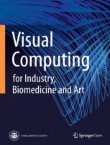China Graphics Society (CGS) is a national, academic, and non-profit organization. It’s founded in 1980 and is affiliated to China Association for Science and Technology. CGS gathers a large number of renowned experts, scholars and science and technology in realm of graphics, with a membership of over 100,000 people. CGS is one of the initiators of International Society for Geometry and Graphics (ISGG), and is its group member. CGS has actively assigned delegations to attend the international Conference on Geometry and Graphics (ICGG) held by ISGG and successfully hosted ICGG in China for many times.
Improvement in resolution of fiber-laser photoacoustic tomography based on a virtual-point concept
In this study, a virtual-point concept was introduced into fiber-laser photoacoustic tomography to improve the elevational image resolution. The flexible fiber laser was bent into an arc shape to conform to th...
